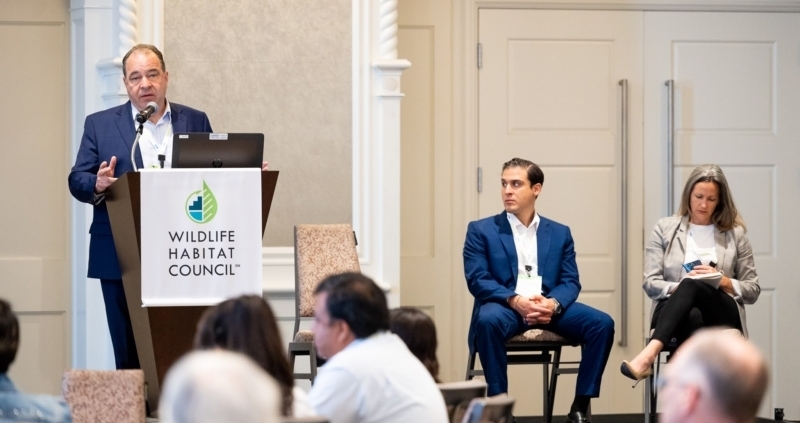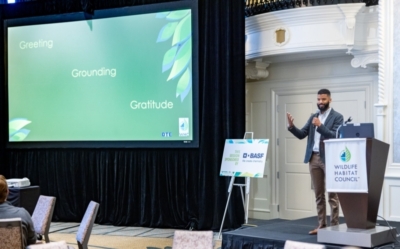The Earth Lab’s Community-First Approach – A Conservation Conference Recap
What is a community-first approach to environmental action? What are the challenges and considerations of partnering with local communities? How can diversity, equity and inclusion be incorporated into these approaches?
These are the questions that Jorge Calderón Trueba and Jorge Calderón Álvarez answered during their Breakfast Briefing session on Day Two of the 2022 WHC Conservation Conference. They’re a father-and-son team — Trueba is the Founder and CEO of The Earth Lab, and Álvarez serves as International Liaison.
Based in Cuauhtémoc, Mexico City, The Earth Lab (TEL) provides tools and guidance on how to create sustainable projects with a goal of helping their clients reach carbon neutral while advancing business goals. Much of TEL’s focus during this session was on their work with ejidos, or state-owned lands that are used communally for agriculture, in Yucatán, Mexico. Support from Ban.CO2 de Carbono Mestizo (BCO2M) and TEL makes it possible for ejidos to sell carbon credits, and through a collaboration with WHC, TEL has gone even further to add biodiversity uplift efforts to these projects. This made for a natural fit to have WHC’s Sara Cook, Director of Business Development, serve as moderator of this session.
Trueba began the session by defining community, a helpful start in understanding how businesses can interface with the broader community. While the more formal definition of community is “an aggregate of people who share common interests in a particular locality,” Trueba used ejidos as an example to illustrate other elements shared by communities, including land ownership, spiritual beliefs, symbiotic relationships with the environment, daily work and income and federal and local laws.
Working directly with communities is not always easy — often, it can present challenges. Trueba explained that communicating effectively, building confidence, practicing empathy and having a constant presence can be some of the obstacles that come along with community-first approaches.
Of particular importance, he noted, is taking care to preserve the communities you’re working with and within. Each community has their own traditional knowledge and values, social structures, heritage, culinary traditions, folklore and craftmanship – all developed and honed over generations. Community participation, then, is key to ensuring that environmental actions will benefit the community rather than disrupt it.
One of TEL’s signature methodologies is the use of Earth Charrettes, which are intensive workshops that include multidisciplinary audience members. These charrettes involve community members in the decision-making process, recognizing their immediate needs and taking local values and interests into account to ultimately make sure the community’s vision for a solution is realized.
Building trust with community members is one of TEL’s top pieces of advice. “Through trust, we can create in them a sense of belonging to their projects and vice versa,” said Álvarez. “This is a key component for their sustainable existence.”
While their community-first actions with ejidos focused on carbon credits, TEL has gone beyond carbon sequestration to provide biodiversity uplift as well. The Ejido Sisal site, which was WHC-Certified earlier this year, provides several great examples of conservation, education and management of natural resources. Located in the Hunucmá Municipality, Ejido Sisal is home to the “Bonos del Jaguar” carbon capture project. This project’s goal is to mitigate climate change by sequestering CO₂, recovering mangroves, protecting jaguars and educating the community about these efforts.
“The Earth Lab Mexico brings vital perspective and expertise to WHC members working in Mexico and Latin America,” said Sara Cook, WHC Director of Business Development. “The model of engagement used by TEL provides many social and environmental benefits, including providing resources and technical expertise to partner ejido communities and preserving cultural heritage and value alongside biodiversity and environmental value.”
“We hope we conveyed to our audience that communities and their participation are a fundamental part of our nature-based solutions (NbS) projects,” Álvarez said, “because only by achieving a joint effort can these projects turn out and remain sustainable.”
TEL offers third-party certification as well as expertise in cities, geo-forestry, corporate/industrial areas, green finance management and even social development and gender equality. To learn more about TEL, visit , follow them on Twitter @TheEarthLabMx, and connect with Jorge Calderón Trueba and Jorge Calderón Álvarez on LinkedIn.


